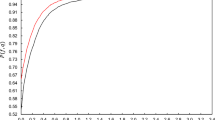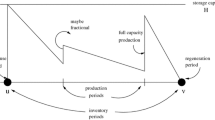Abstract
Lot sizing procedures for discrete and dynamic demand form a distinct class of inventory control problems, usually referred to asmaterial requirements planning. A general integer programming formulation is presented, covering an extensive range of problems: single-item, multi-item, and multi-level optimization; conditions on lot sizes and time phasing; conditions on storage and production capacities; and changes in production and storage costs per unit. The formulation serves as a uniform framework for presenting a problem and a starting point for developing and evaluating heuristic and tailor-made optimum-seeking techniques.
Similar content being viewed by others
References
Denzler, D. R.,A Heuristic Production Lot Scheduling Model, AIIE Transactions, Vol. 2, pp. 59–63, 1970.
Johnson, L. A., andMontgomery, D. C.,Operations Research in Production Planning, Scheduling and Inventory Control, John Wiley and Sons, New York, New York, 1974.
Kaimann, R. A.,A Comparison of EOQ and Dynamic Programming Inventory Models with Safety Stock and Variable Lead-Time Considerations, Production and Inventory Management, Vol. 15, pp. 1–20, 1974.
Majewicz, D., andSwanson, L. A.,Inventory Ordering and Quantity Discounts with Time-Varying Demand: A Programming Application, Production and Inventory Management, Vol. 19, pp. 91–102, 1978.
Wagner, H. M.,Principles of Operations Research, Prentice-Hall, Englewood Cliffs, New Jersey, 1975.
Eisenhut, P. S.,A Dynamic Lot Sizing Algorithm with Capacity Constraints, AIIE Transactions, Vol. 7, pp. 170–176, 1975.
Orlicky, J.,Material Requirements Planning, Chapter 6, McGraw-Hill Book Company, New York, New York, 1975.
Goyal, S. R.,Integrated Inventory Model for a Single Product System, Operations Research Quarterly, Vol. 28, pp. 539–545, 1977.
New, C. C.,Lot Sizing in Multilevel Requirements Planning Systems, Production and Inventory Management, Vol. 15, pp. 57–62, 1974.
Walker, W. E.,A Heuristic Adjacent Extreme Point Algorithm for the Fixed Charge Problem, Management Science, Vol. 22, pp. 587–596, 1976.
Murty, K. G.,Linear and Combinatorial Programming, p. 398, John Wiley and Sons, New York, 1976.
Pollatschek, M., Private Communication, 1979.
Smith, D.,Linear Programming Models in Business, p. 211, Polytechnic Press, Brooklyn, New York, 1973.
Driebeek, N. J.,Applied Linear Programming, p. 126, Addison-Wesley Publishing Company, Reading, Massachusetts, 1969.
Karni, R.,Maximum Part-Period Gain—A Lot Sizing Procedure for Unconstrained and Constrained Requirements Planning Systems, Production and Inventory Management, Vol. 22, 1981.
Karni, R.,A Uniform Order Quantity Lot Sizing Technique for Varying Demand Rates, Production and Inventory Management, Vol. 21, pp. 29–36, 1980.
Karni, R., andRoll, Y.,Dynamic Multi-Item Lot Sizing—A Heuristic Technique, Operations Research Series No. 294, Technion, Haifa, Israel, 1981.
Author information
Authors and Affiliations
Additional information
Communicated by M. Avriel
Rights and permissions
About this article
Cite this article
Karni, R. Integer linear programming formulation of the material requirements planning problem. J Optim Theory Appl 35, 217–230 (1981). https://doi.org/10.1007/BF00934577
Issue Date:
DOI: https://doi.org/10.1007/BF00934577




